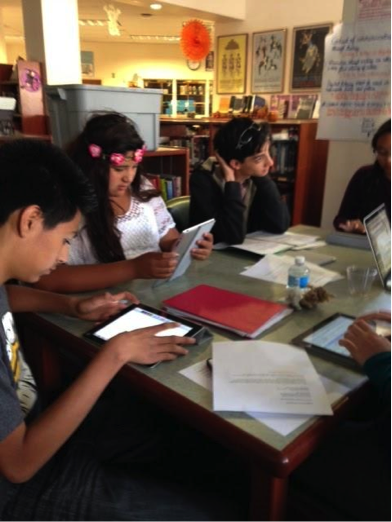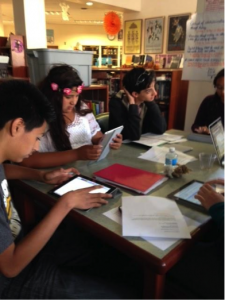Writing across the Curriculum at Santa Fe Indian School
0December 16, 2014 by Susan Miera

Writing Across the Curriculum: It’s Easier Than You Think
Writing Across the Curriculum, Literacy and Technology Workshop, October 8-9, 2014
Hosted by Santa Fe Indian School, Bread Loaf School of English, and Write to Change
Susan Miera is a founding member of the Bread Loaf (Rural) Teacher Network, a semi-retired English teacher with 40 years of secondary language arts teaching experience. and coordinator of the Santa Fe Indian School Writing Center. After becoming involved with BLTN in 1993 and graduating from the Bread Loaf School of English in 1997, she continues to plan and co-lead yearly workshops with Alicia Fritz on Writing Across the Curriculum and Writing Centers at SFIS.
Alicia Fritz has been teaching English III and AP Language and Composition to juniors at Santa Fe Indian School since January 2008. After becoming involved with BLTN in the Fall 2012 and attending the Bread Loaf Santa Fe campus during Summer 2013, she continues to plan and co-lead yearly workshops with Susan Miera on Writing across the Curriculum and Writing Centers at SFIS. Alicia has a Bachelor’s of Arts from Binghamton University, MFA in Fiction Writing from Sarah Lawrence College and MS ED in Secondary Ed from Hofstra University.
Presenters:
- Alicia Fritz, LA Department Chair, English III and AP English Language, Santa Fe Indian School, Santa Fe, NM
- Susan Miera, Bread Loaf Teacher Network, Santa Fe Indian School Writing Center Coordinator, MA ’97
- Distance Presenter: Paul Barnwell, English III and Digital Media teacher, Fern Creek High School, Louisville, KY
In this article, we present our reflections on the October 8-9 workshop at Santa Fe Indian School. Readers interested in detailed descriptions of the conference sessions and links to selected digital resources may find them here.
Alicia Fritz—Santa Fe Indian School Teacher/Facilitator
At our first 2014-2015 Writing across the Curriculum workshop in October at Santa Fe Indian School, I left the workshop thinking about the following questions: How can we encourage content area teachers to implement writing across the curriculum in their classrooms? How can we support staff in this endeavor so it does not feel like another initiative that they are required to implement? How can teachers work together with their students to engage authentically in creating units/lessons/activities that promote content area literacy through the use of technology and/or Writing across the Curriculum? These are challenging questions, but I feel that our most recent workshop helped both teachers and students to begin to investigate more deeply and to acquire the answers to continue this discussion at both SFIS and Monte del Sol .
Overview of Days 1 & 2 : On day one, Susan and I were able to adapt our schedule to the needs of our participants and the use of technology. I really enjoyed the dialogue about digital literacy on Wednesday morning. I think this was an important way to “break the ice” and create a sense of comfort that is necessary when we work together at each session.
To begin, I gave an overview about Writing across the Curriculum and how it helps to facilitate understanding and comprehension in all content areas. I think it is important to understand that we are not asking content area teachers to “teach” writing but rather use it to help students articulate their understanding of content area material. For some previous participants, this was a review, but we had quite a few new workshop members last week. As I read the email responses on BreadNet from staff and read their emails, I realized that many of them are already using writing to some extent in their classrooms to show learning. I think that the web resources that we have included as part of the workshop will provide additional information to assist staff in using WAC.
We had a very fruitful discussion about the role of technology in our lives, which was a perfect prelude to the digital literacy component on day two. Susan covered the connections between CCSS literacy standards and the math standards in order to show the connections between both of them. As well, we presented the iPad app Educreations, ITunes University and the WAC website for Baltimore Public Schools. The participants’ day two mini-lessons reminded me that time to explore the technology is an important element before setting the parameters of an “assignment.”
The Skype call with Paul Barnwell, BLTN from Louisville, Kentucky, and the video-inspired prompts were equally rewarding on day two. I know that our students and staff enjoyed learning from Paul and his students about digital literacy. Paul tailored his examples by creating fictitious students who seemed to be plausible for SFIS. Paul shared critical information about creating a positive digital presence as students prepare to enter the workforce and attend college. Alfredo Lujan’s video-inspired writing prompts really helped students and staff to think critically and respond to the ideas presented. Alfredo showed clips from Ferris Bueller’s Day Off which focused on learning outside the classroom and culminated with the slide show about Monte del Sol’s hiking trip near Atalaya. The quick videos and quick writing responses showed that you do not need to write a lot to show understanding. This type of writing could be used in all content areas to explore ideas.
Susan Miera—BLTN, SFIS Writing Center Coordinator/Facilitator
What I’d like to reflect upon is the importance of this particular workshop.
As Alicia and I planned for our first two-day session of the 2014-15 school year, I realized I was entering new territory by combining technology with writing across the curriculum. As a teacher, I’d oftentimes used writing strategies that could be used across the curriculum, but I’d never really bridged the technological gap with other disciplines. I’d indeed used computers and various applications in the teaching of writing in my language arts classes, and for many years I taught students to document their work using various mediums and media sources.
But this was different. I was tasked to help teachers and students in all disciplines find meaning in their writing by using technologies that I had not field tested in my own classrooms. So began the quest for information and for help from those around me. I read article after article about what teachers were doing across the country . . . in their own classrooms . . . with their own students. Some of it was daunting; some of it was rudimentary; all of it was helpful. I learned very quickly what I liked, what I didn’t, what I thought would be helpful, what was pure bunk (in my mind, anyway). But the pure volume of information was overwhelming some days.
So I finally took a deep breath and listened to my inner self. I heard my own voice telling countless students over forty years of teaching that “you write best about what you know best.” This was no exception. I needed to heed my own advice and teach about what I knew best . . . Students learn from teachers who know their content and are excited about talking about it.
Writing is a conversation on paper about a subject that is relevant to a given time . . . whether that time be right now for a minute or for a long time to come. I could do that. I’d done it all my teaching career, and this workshop was no different. So I perused the volumes of information, and I began to throw out things I knew I could never talk about if it were in my own classroom filled with students. I kept those I personally found exciting, things that I would have drawn from in my own classroom, things I thought students might enjoy. My underlying thought was that education should be both fun for the teacher and for the students. A happy teacher makes happy students, and happy students make happy teachers. Sounds simplistic, but it gave me purpose as I started to formulate a plan for a two-day workshop on writing across the curriculum and the use of technology in implementing it.
In retrospect, I think both Alicia and I overplanned, overanalyzed, and overanticipated. I caused my own stress and my own anxiety. But I also realize I can have fun with stress. I can impart information that is researched but not comfortable, and I can enjoy teaching in a new way.
I learned a tremendous amount about why digital literacy and digital citizenship are so important in the 21st century. I’ve learned that the Common Core has some great elements as long as teachers can still have some autonomy in their classrooms, and I’ve re-learned that students are our most underused resources. These were important lessons for me and, I believe, for the participants of this workshop.
I’d like to extend a sincere thank you to Santa Fe Indian School for their unending support and confidence in me and in the staff and students in this community, to Bread Loaf School of English for a continued partnership with SFIS, to Alicia Fritz for her invaluable help and dedication to writing across the curriculum, and to Dixie Goswami through Write to Change for her incredible energy and her continued fight to make writing important in all our lives.
Category BLTN Teachers, Campus News, Fall 2014 | Tags:

Leave a Reply